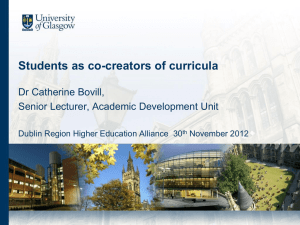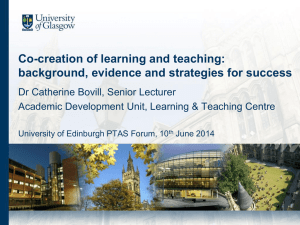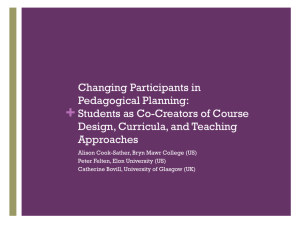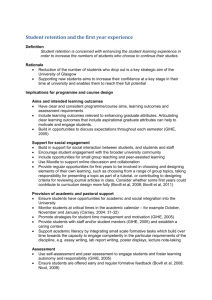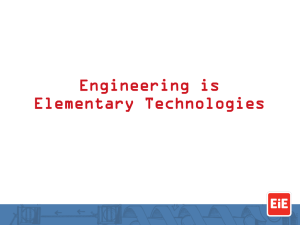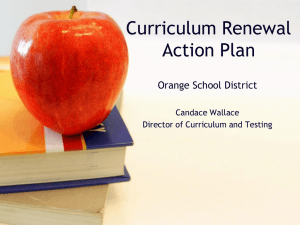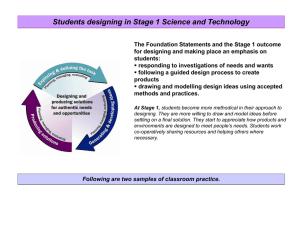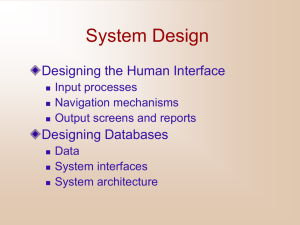Staff and students co-creating curricula
advertisement
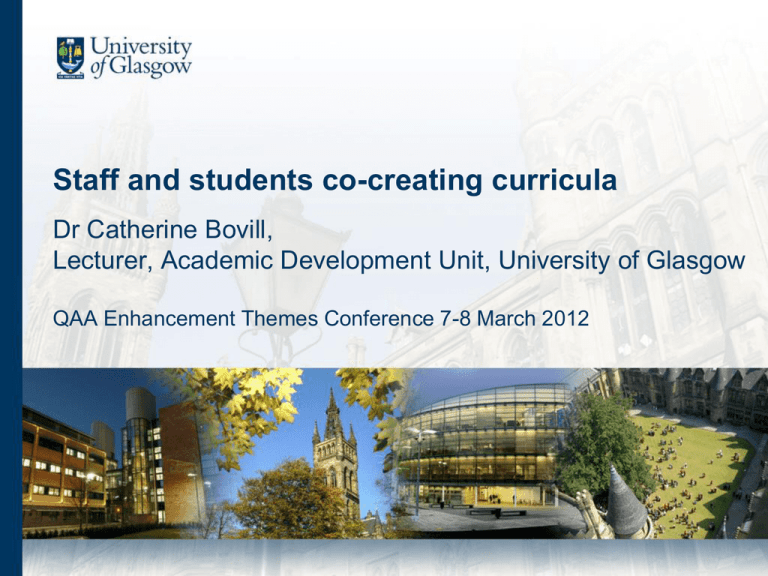
Staff and students co-creating curricula Dr Catherine Bovill, Lecturer, Academic Development Unit, University of Glasgow QAA Enhancement Themes Conference 7-8 March 2012 Overview Background rationale and evidence Possible and desirable levels of participation Examples of different types of participation Challenges and possible solutions Your practice What is the curriculum? Fraser & Bosanquet’s (2006) curriculum definitions a) Structure and content of a unit b) Structure and content of a programme of study c) The students’ experience of learning d) A dynamic and interactive process of teaching and learning (p272) HE Lit supporting co-created curric Students as co-creators/co-producers of their learning (Bovill et al, 2011& 2009; McCulloch, 2009; Neary, 2010; SFC, 2008) Literature calling for student participation in curriculum design from critical pedagogy and popular education (Darder et al, 2003; Dewey, 1916; Fischer, 2005; Freire, 1993; Giroux, 1983; Rogers and Freiberg, 1969) Specific student participation in curriculum design Breen & Littlejohn (2000) Language teaching Samson & Scandrett (1999) Environmental justice Fischer (2005); Delpish et al ( 2010) Education Bovill et al, (2011); Cook-Sather (2010) non-disciplinary specific Enhanced graduate attributes Student outcomes Performance in assessments Individual and group responsibility Collaborative learning Group cohesion Autonomy Confidence and motivation Understanding of the learning process Understanding of curricular design as a complex process (Bovill forthcoming; Bovill et al, 2011; Cook-Sather, 2008) Impact on staff Staff outcomes Understanding of the learning process Confidence and motivation Satisfaction from witnessing student outcomes Rich experience from genuine dialogue with students Intense / demanded a lot Nerve-wracking Transformatory (Bovill, forthcoming; Bovill et al 2011; Delpish et al, 2010) Examples of student participation • • • • • • • • student course questionnaire feedback students choosing the topic for their research project students co-designing marking criteria with staff students and staff collaborating to choose a course text book students influencing the content of the curriculum students as full members of a programme curriculum design team students designing the VLE for a programme students designing (one of?) their own learning outcomes Ladder of student participation in curriculum design Students in control Students as full members of curriculum design team Partnership - a negotiated curriculum Student control of some areas of choice Students control of prescribed areas Wide choice from prescribed choices Limited choice from prescribed choices Participation claimed, tutor in control Dictated curriculum – no interaction Students control decision-making and have substantial Students designing influence their own learning outcome(s) Students have some choice and Designing a VLE influence Tutors control decision-making informed by student feedback Stud ents incre asin gly activ e in parti cipat ion Gathering feedback Tutors control from students… decision-making Depends what you do with the feedback Words of caution… Higher up the ladder is not necessarily ‘better’ Beware of chasing the nirvana of total participation and totally equal participation Different points on the ladder might be possible or desirable in different contexts The ladder is simply a model to facilitate discussion Examples of co-created curricula 1) Do you have any examples of co-created curricula? 2) Where would you place them on the ladder? Pre-design decisions Tutors as gatekeepers… • Which students? Retrospective, current or future design? • Selecting students – if not all students by interview/criteria • Do you reward your students? • Course, programme or extra-curricular? • Students involved in designing curriculum process or content? Bovill (forthcoming) Some big questions… I teach first years and Wethey are don’t all have 20 years of and experience like overstretched this IWe only have teach a these me tolike know what needs more professional studentssounds for body twothat weeks to be work… constrains and the course what we is in co-the content of first year chemistry ordinated can do with bythe our someone curriculum… else… curriculum… Challenges and solutions In small groups, raise up to 3 key challenges to students and staff co-creating curricula Swap papers with another group and come up with solutions to the challenges you have been set. After today… Write down a short plan of what you plan to do next… - What do you need to find out more about? - What area of your practice do you intend to consider making a change to? - Who do you plan to speak to about your ideas? Who could perhaps support you in this work? - What would help you ensure that your idea is translated into reality?
